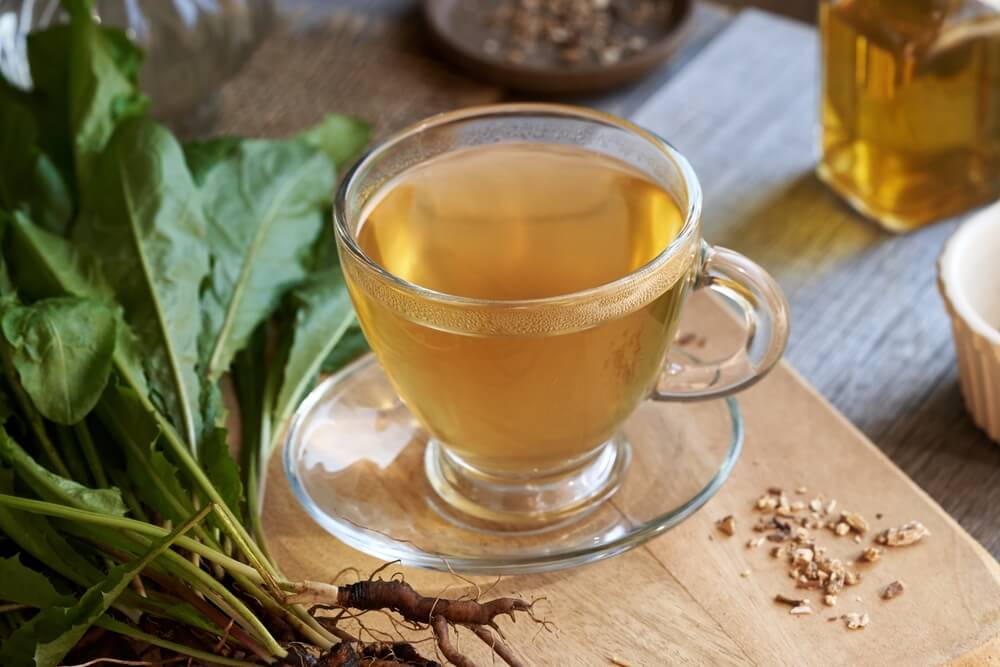How To Make Dandelion Root Tea: A Healthy Drink

Dandelion root tea is a healthy and cleansing herbal drink people have used for years. To make it, clean and cut the dandelion roots. Next, let them steep in hot water for 15 minutes. This straightforward guide will show you how to make dandelion root tea, from picking the roots to brewing a delicious cup.
Dandelion root tea is a nourishing and detoxifying drink. It aids in digestion and liver detox. Dandelion root contains vitamins A, C, and K and minerals such as iron and calcium. Making dandelion root tea at home is easy and offers a natural way to improve your health.
In addition to its nutritional value, dandelion tea has a rich, earthy aroma. You can improve the flavor by adding honey or lemon. Regular consumption of this tea maintains overall health. To be safe, always ensure the dandelion root is sourced from a pesticide-free area. Enjoy the benefits of this natural, health-enhancing drink.
4 Benefits Of Dandelion Root Tea:
Many look for healthier alternatives to traditional beverages. Dandelion root tea is a fantastic alternative. This tea not only tastes great but also offers many health benefits. Let’s explore the benefits of dandelion root tea and why you should consider adding it to your daily routine.
- Nutritional Value:
Dandelion root tea is packed with essential nutrients. It contains vitamins and minerals that are essential for your health. Here’s a breakdown of the nutrients:
- Vitamins: Include A, C, K, and various B vitamins.
- Minerals: Iron, Calcium, Magnesium, and Potassium.
- Fiber: Supports digestion and helps keep your gut healthy.
Apart from these, dandelion root tea is low in calories. A cup of this tea contains only 25 calories. This makes it a perfect drink for those watching their calorie intake. The nutrients in dandelion root tea support various bodily functions. They boost immunity, improve bone health, and improve skin quality.
- Lowers Blood Sugar:
Dandelion root tea can help control blood sugar levels. It is especially beneficial for diabetics. Several compounds in dandelion root work together to lower blood sugar levels. Here’s how it helps:
- Chicoric and Chlorogenic Acid: These compounds improve insulin secretion.
- Anti-inflammatory properties: Reduces inflammation, which can affect blood sugar levels.
Research shows that regular consumption of dandelion root tea helps stabilize blood sugar levels. This makes it a great addition to a diabetes-friendly diet. Check with your doctor before making significant adjustments to your diet.
- Gives Tons Of Antioxidants:
Dandelion root tea is rich in antioxidants. Antioxidants are agents that guard your cells against damage. Drinking this tea regularly has many health benefits. Some of the antioxidants found in dandelion root tea include:
- Beta-carotene: Protects cells from oxidative stress.
- Polyphenols: Reduces risk of chronic diseases.
These antioxidants fight free radicals in your body. Free radicals can harm cells and lead to different health issues. By drinking dandelion root tea, you can boost your antioxidant intake. It helps reduce the risk of heart disease, cancer, and other ailments.
- Lowers Cholesterol:
Dandelion root tea may help lower cholesterol levels. High cholesterol is a risk factor for many cardiovascular diseases. Dandelion root compounds work effectively to lower cholesterol. Here’s how:
- Fiber: Binds cholesterol and removes it from your body.
- Phytosterols: compete with cholesterol for absorption, reducing its levels.
Regular consumption of dandelion root tea can significantly lower LDL cholesterol, often called bad cholesterol. Lowering LDL levels helps maintain a healthy heart. Incorporating this tea into your daily routine can be an easy way to improve your cardiovascular health.
How To Choose Dandelion Roots:

Dandelion root tea is a delicious and healthy drink with nutrients and antioxidants. Before you start making this tea, choosing the proper dandelion root is essential. The root’s quality will significantly affect your tea’s taste and benefits. Let’s explore how to select the best dandelion roots for your tea.
- Wild Vs. Store-bought:
There are two primary options for sourcing dandelion roots: wild and store-bought. Each has advantages and disadvantages, depending on your preferences and availability.
Wild dandelion roots are often fresher and more natural. They are grown in their natural environment, free from chemicals and pesticides. Here are some benefits:
- Organic: No exposure to harmful chemicals.
- Freshness: Collected directly from the soil.
- Cost-Effective: Free if you drink them yourself.
However, wild dandelion root also has some drawbacks:
- Time-consuming: Finding and harvesting requires effort.
- Potential Pollution: The risk of pollutants in certain areas.
Store-bought dandelion root is convenient and readily available. These roots are usually dried and packaged for ease of use. Here are the benefits:
- Pros: Easily accessible at health stores or online.
- Safety: Tested frequently for contaminants.
- Consistency: Uniform quality and size.
But, store-bought roots come with some disadvantages:
- Cost: It can be more expensive than collecting wild roots.
- Less fresh: Wild roots may need more freshness.
Make decisions based on your priorities and resources. Both options can make a delicious and healthy tea.
- Harvesting Tips:
If you choose to harvest wild dandelion roots, follow these tips to ensure you get the best quality:
- Identify the right plant: Look for dandelions with bright yellow flowers and ruffled leaves.
- Harvest in the proper season: Early spring or late fall is the best time to harvest.
- Choose the right location: Avoid areas near roads or industrial sites to reduce pollution exposure.
- Use the right tools: A small garden fork or hoe can help you dig up the roots without damaging them.
Follow these steps for harvesting:
- Dig deep: Dandelion roots can be long, so dig deep to get the whole root.
- Clean thoroughly: Rinse the roots under cold water to remove dirt and debris.
- Dry properly: Spread the roots on a clean surface and let them air dry for a few days.
- Store properly: Once dried, store the roots in an airtight container to preserve freshness.
These tips will help you harvest high-quality dandelion roots, ensuring a delicious and nutritious tea.
How To Make Dandelion Root Tea: Preparation Steps

Making dandelion root tea is a delightful way to enjoy a healthy drink. There are a few essential steps involved in preparing this tea. Below, we’ll walk you through the preparation steps to ensure you know how to make dandelion root tea.
- Cleaning The Roots:
Cleaning the dandelion roots is an essential first step. This ensures you remove all the dirt and impurities. Follow these steps:
- Collect fresh dandelion roots from a clean, pesticide-free area.
- Trim off leaves and small roots using a pair of garden shears.
- Rinse the roots under cold running water. Scrub off any dirt with a vegetable brush.
- Cut the roots into small pieces for easy cleaning.
- Soak the root pieces in a water bowl for 10 minutes to loosen any remaining dirt.
After soaking, rinse the roots again under running water. Make sure they are spotless before moving on to the next step.
- Drying Process:
Dandelion root drying is essential to prepare for tea. Follow these steps:
- Preheat your oven to 200°F (93°C).
- Spread the clean core pieces on a baking sheet. Make sure they are on a single layer for even drying.
- Place the baking sheet in the oven and let the roots dry for about 2 hours. Check them every 30 minutes to make sure they aren’t burning.
- Alternatively, you can air-dry the roots. Spread them on a clean cloth and keep them in a well-ventilated place. This process may take several days.
When dry, the roots should be hard and brittle. Keep them fresh for later by storing them in an airtight container.
How To Make Dandelion Root Tea: Brewing Techniques
Dandelion root tea is a nutritious and delicious drink with many health benefits. To make the perfect cup of this herbal infusion, you need to master a few brewing techniques. Below, I’ll explore two popular methods: the infusion method and the cold brew option.
Each technique brings out dandelion root’s different flavors and benefits, ensuring you get the most out of this healthy drink. So, let’s learn brewing techniques and how to make dandelion root tea properly.
- Infusion Method:
The infusion method is an easy and effective way to make dandelion root tea. This technique allows the roots to release their nutrients and flavors into the water. Follow these steps for a perfect infusion:
Ingredients:
- 1-2 teaspoons of dried dandelion root
- 1 cup of water
Instructions:
- Boil water in a pot or kettle.
- Add dried dandelion root to a tea infuser or directly to the pot.
- Pour boiling water over the dandelion root.
- Cover and let steep for 10-15 minutes.
- If you are using loose roots, strain the tea into a cup.
- Enjoy your hot dandelion root tea.
Pro Tip: For a more robust flavor, let the tea steep for up to 20 minutes. To enhance the taste, add honey, lemon, or a cinnamon stick.
- Cold Brew Option:
The cold brew option is perfect for hot summer days and offers a mild, smooth taste. This method requires more time but is equally easy to prepare. Here’s how you can make cold-brew dandelion root tea:
Ingredients:
- 2-3 teaspoons of dried dandelion root
- 2 cups of cold water
Instructions:
- Place the dried dandelion root in a jar or pitcher.
- Pour cold water over the roots.
- Seal the jar and store it in the refrigerator.
- Let it steep for 12-24 hours.
- Strain the tea into a glass or other jar.
- Serve chilled, optionally, with ice cubes.
Pro Tip: For an extra refreshing taste, add fresh mint leaves or a slice of orange to the jar before refrigerating.
Storage Tips:
Dandelion root tea is a delightful and healthy drink. Knowing the right storage tips will ensure your tea stays fresh and tasty for as long as possible. Let’s dive into the best ways to store your dandelion root tea and keep it full of flavor and nutrients.
- Shelf Life:
Proper storage extends the shelf life of your dried dandelion root tea.
Here are some key points to consider:
- Airtight container: Store your dried dandelion roots in an airtight container. It keeps moisture and air out.
- Cool and dark place: Store the container in a cool, dark place. Heat and light can damage the roots.
- Avoid moisture: Ensure that the storage area remains dry. Moisture can cause mold to grow on the roots.
To give you a better idea, here is a table summarizing shelf life based on different storage conditions:
| Storage Condition | Shelf Life |
| Airtight Container in a Cool, Dark Place | Up to 1 year |
| Non-Airtight Container | 3-6 months |
| Humid Environment | Less than 3 months |
Remember, the fresher the root, the better the tea. Always inspect for any signs of spoilage before using.
- Best Practices:
Following best practices ensures that your dandelion root tea stays fresh and potent.
Here are some tips:
- Label your containers: Always label your containers with the storage date. It helps you keep track of freshness.
- Use Glass Jars: Glass jars are best for storage. They do not react with the tea, so they keep it fresh.
- Avoid plastic containers: Plastic can affect the taste and quality of tea.
For optimal freshness:
- Buy high-quality dandelion roots.
- Store them in a clean, dry, and airtight container.
- Store the container in a cool, dark location.
These steps ensure that your tea will remain delicious and nutritious. Follow these best practices to enjoy the best dandelion root tea every time you make a cup.
Related Questions:
What Happens When You Drink Dandelion Root Tea Everyday?
When drinking dandelion root tea, do not mix it with water pills (diuretics), as both can cause excessive fluid loss. It’s also a good idea not to mix it with blood thinners, as this can affect how dandelion works.
Avoid adding a lot of sugar or sweeteners, which can reduce the tea’s health benefits. Always check with your doctor if you are taking any medication.
What Not To Mix With Dandelion Root Tea?
When drinking dandelion root tea, do not mix it with water pills (diuretics), as both can cause excessive fluid loss. It’s also a good idea not to mix it with blood thinners, as this can affect how dandelion works.
Avoid adding a lot of sugar or sweeteners, which can reduce the tea’s health benefits. Always check with your doctor if you are taking any medication.
Who Should Not Drink Dandelion Tea?
People allergic to dandelions or plants like ragweed, marigolds, or daisies should not drink dandelion tea. If you take water pills, blood thinners, or medicine for diabetes or high blood pressure, talk to your doctor first, as dandelion tea could affect your medicine.
Pregnant or breastfeeding women should also be careful and ask their doctor before drinking dandelion tea.
Conclusion:
Learning how to make dandelion root tea is an easy and enjoyable way to benefit from its health perks. Just follow the steps to pick the roots and brew the tea, and you’ll have a great addition to your daily routine. Whether you want a detox boost or a relaxing drink, making dandelion root tea at home is simple and helpful. Enjoy making and drinking this tasty herbal tea.







I really appreciate this post. I have been looking all over for this! Thank goodness I found it on Bing. You’ve made my day! Thank you again
This actually answered my drawback, thank you!
I was very pleased to find this web-site.I wanted to thanks for your time for this wonderful read!! I definitely enjoying every little bit of it and I have you bookmarked to check out new stuff you blog post.
Very wonderful visual appeal on this internet site, I’d rate it 10 10.
Great awesome things here. I am very happy to look your article. Thanks so much and i am taking a look forward to touch you. Will you please drop me a e-mail?
whoah this blog is fantastic i love reading your articles. Keep up the great work! You know, many people are hunting around for this information, you can aid them greatly.